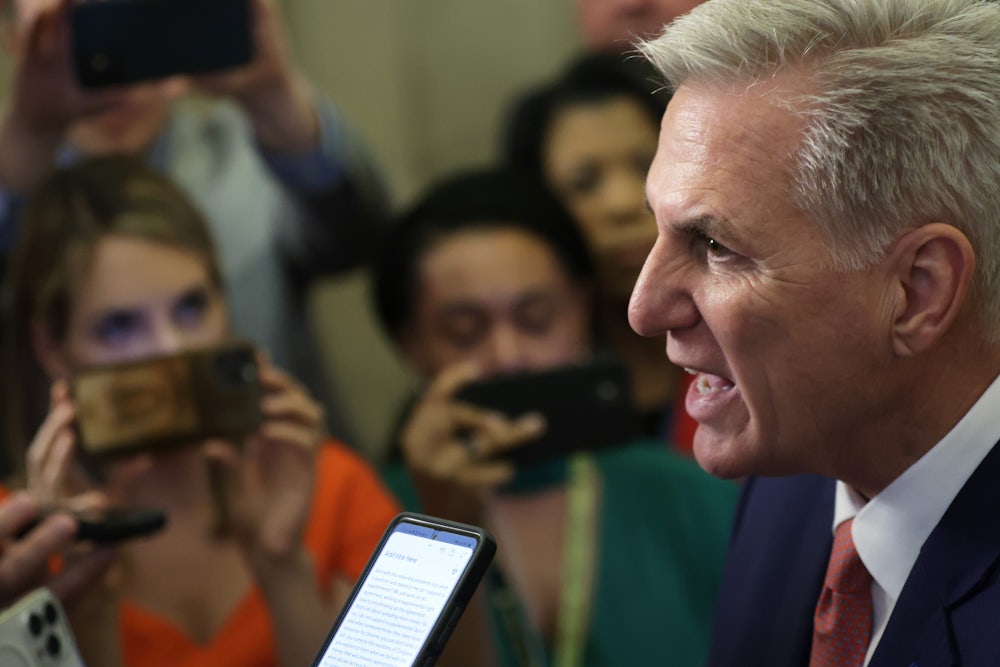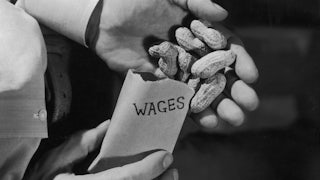The House GOP spent the past four months screaming about the deficit. “We must move towards a balanced budget,” House Speaker Kevin McCarthy said on February 6. McCarthy felt so strongly about this that in April he pushed through the House a bill threatening default unless the Biden administration agreed to $4.8 trillion in spending cuts. Eventually, McCarthy settled for about $1.5 trillion. House leaders crowed that it was “the largest deficit reduction package in American history.”
With that accomplishment behind them, House Republicans are now examining ways to eliminate these savings and blow a new hole in the deficit. How? By the usual Republican method: tax cuts. In this case, expanding the 2017 Trump tax cuts. And it doesn’t look as though Democrats intend to put up much of a fight.
In 2017 President Donald Trump signed into law a tax bill that, despite his administration’s delusional claims that it would pay for itself, cost the Treasury $1.7 trillion in lost revenue. The deficit, which Republicans profess to revile, is today $1.5 trillion. Had the Trump tax bill never been passed, there would be no deficit; we’d have a $200 billion surplus.*
The priciest feature of the Trump tax cut was a reduction in the top corporate tax rate from 35 percent to a uniform rate of 21 percent. The justification was that the nominal tax rate on corporations in the United States was higher than in peer nations. In fact, when you figured in various deductions and exemptions, the average effective tax on large, profitable corporations was lower than in peer nations—a measly 16 percent, according to the Government Accountability Office, or GAO. Half of all large corporations paid no corporate tax at all. The Trump tax cut drove the effective corporate tax lower still, to about 9 percent.
Before the Trump tax cut, corporate tax revenue represented about 2 percent of gross domestic product, or GDP, compared to 3 percent in member nations of the Organization for Economic Cooperation and Development. After the Trump tax cut, corporate tax revenue represented about 1 percent of GDP. The corporate tax rate is low by historic standards too. It’s about half of what it was in the 1970s, and considerably less than half of what it was in the 1950s under the stolidly pro-business Republican President Dwight Eisenhower. Through the ’50s and ’60s, corporate taxes never fell below 3 percent of GDP.
Before Trump, politicians in both parties had talked for years about cutting corporate tax rates in exchange for eliminating corporate tax loopholes—tax simplification rather than tax reduction. The concept was patterned after the revenue-neutral 1986 tax bill, which swapped lower rates for a broader tax base. But many Democrats resisted this idea because they suspected Congress would opt for a tax cut rather than tax simplification. These suspicions proved to be well founded.
Granted, the 2017 bill included a few minor revenue-raising tweaks to offset part of the bill’s cost. These revenue sources are what congressional nerds call “pay-fors.” But now House Ways and Means Chairman Jason Smith, Republican of Missouri, is preparing to reverse three of these. “Republicans are committed to helping Americans keep more of their hard-earned money to spend, save, or invest as they need,” Smith told The Wall Street Journal’s Richard Rubin this week.
The first tweak that House Republicans want to undo is a limit that the 2017 bill placed on the interest deductions that businesses can claim. Under the 2017 change, deductions were limited to 30 percent of adjusted taxable income; previously they were 50 percent. This restriction became more costly after the Federal Reserve started raising interest rates to fight inflation. Corporations paid more interest on their debt even as the IRS restricted more tightly how much of that interest they could deduct from taxes.
The second tweak Republicans want to reverse is the phasing out of a generous deduction for capital expenditures on machinery expected to last 20 years or less. The 2017 tax bill permitted corporations to deduct such expenditures in a single year where previously they’d had to deduct them over several years. But this was a short-term measure. The amount eligible to be deducted started at 100 percent, then fell to 80 percent, then 60 percent, and, eventually, in 2026, to zero. The idea was to prod corporations into making capital investments sooner rather than later. If Congress now limits or eliminates this phaseout, that will increase the cost to the Treasury and remove the incentive to accelerate capital investment.
The third change Republicans want to make would revive a short-term measure in the 2017 law that expired in 2021. This was a deduction concerning research and development expenditures. As with the capital-expenditures measure, the R&D provision gave companies an opportunity to deduct investment in a single year on an “act now” basis, because the deduction would only be temporary. But in this instance, the deduction wasn’t phased out; it was simply put in place for three years and then removed.
Democrats are sympathetic to all three proposed tweaks, and especially to the third, if it can be matched with an increase to the child tax deduction that Republicans don’t especially want. I’m sure that, viewed narrowly, at least some of these proposed changes might be justifiable: They’re narrowly targeted, they might boost productivity, etc. But they bump up against the larger reality that corporate taxation has already been eviscerated in this country, to the benefit of very few. Indeed, according to a report prepared for the Joint Committee on Taxation, not a penny of the 2017 corporate tax cut landed in the pocket of anyone in the bottom 90 percent of the U.S. income distribution.
Pairing some of the House GOP’s proposed narrow tax cuts with expansion of the child tax credit is an acceptable idea only if it’s attached to other reversals of the 2017 tax law, starting with a restoration of a 35 percent top corporate tax rate.
Biden has proposed raising the top corporate rate to 28 percent, which isn’t enough; we all managed just fine when it was 35 percent. The top capital gains rate, which Trump wanted to lower to 15 percent, should be raised from the present 20 percent to equal the top income-tax rate, because income from capital shouldn’t be taxed any differently from income from labor. The 2017 law lowered the top individual income-tax rate from 39.6 percent to 37 percent. Biden has proposed raising it back to 39.6 percent.
That isn’t high enough either. I am 65 years of age. In the year of my birth, the top income tax rate was 91 percent and the U.S. economy was the envy of the world. I would settle for a top rate of 70 percent, which is where it stood the year I turned 7, the age of reason. The top rate remained at 70 percent when I entered the workforce at 23. Really, it wasn’t that big a deal.
Biden would set the threshold for his 39.6 percent top rate on income exceeding $400,000, on the theory that people making less than $400,000 are middle class. Nonsense. If you earn $400,000 (or even $300,000), you’re richer than 95 percent of your fellow Americans, according to my new favorite app, The Washington Post’s “Are You Middle Class?” calculator. There’s nothing remotely “middle” about being in the top 5 percent. Biden proposes setting the top capital gains rate at the same 39.6 percent, but only for people earning in excess of $1 million, which is similarly ridiculous.
But if Biden doesn’t go far enough, he still goes too far for congressional Democrats, which is very dispiriting. Even when they held majorities in the House and Senate, Democrats wouldn’t support his tax increases. Trump’s income tax cuts are set to expire in 2025, but even Biden would preserve most of these in the interest of protecting the under-$400k set. President Barack Obama did much the same thing, preserving most of President George W. Bush’s tax cuts to protect people making up to $250,000.
The GOP has been beggaring the Treasury for decades, and Democrats have mostly let it get away with it. By the end of this year, according to Bobby Kogan of the Center for American Progress, two Republican presidents—George W. Bush and Donald Trump—will have pissed away through tax cuts a combined $10 trillion in revenue. A third, Ronald Reagan, pissed away (in current dollars) trillions more.** (Breaking with this tradition, George H.W. Bush, who campaigned in 1988 as an anti-tax demagogue, changed his mind after he became president and raised the top income tax rate from 28 percent to 31 percent. That may have cost him reelection in 1992.) Reagan, Bush, and Trump made the U.S. a fiscal backwater. Since commensurate spending cuts would be catastrophic, these three Republican presidents also made us a perpetually insolvent country (apart from a brief moment at the end of the Clinton administration when the budget was in surplus). If there were a Mount Rushmore for outrageous fiscal irresponsibility, they’d all three be carved there in granite.
Kevin McCarthy can mouth off all he wants about a balanced budget, but whatever tax cuts his caucus settles on will make this insolvency problem worse by showering money on the people who need it least. Not a word he ever says about government debt should be taken seriously until he agrees to raise taxes, which will be never.
* This article previously misstated the projected surplus.
** An earlier version of this piece mischaracterized Kogan’s dollar estimate of the cost of Reagan’s tax cuts.






